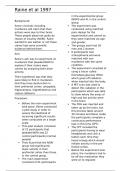Week 2:
Preparation: Chap 3: Consumer choice, price
index.
Budget constraints are faced by consumers as a result of limited incomes.
The budget line is all combinations of goods for which the total amount of money
spent is equal to income. Its slope is negative of the ratio of the prices of the two
goods.
Maximization of the market basket follows 2 conditions:
- Must be located on the budget line
- Must give the consumer the most preferred combination of goods and
services.
Satisfaction is maximized when marginal rate of substitution (of F for C) is equal to
the ratio of the prices.
Marginal benefit is the benefit from the consumption of one additional unit of a good.
Marginal cost is the cost of one additional unit of a good.
Satisfaction is maximized when the marginal benefit=marginal cost.
Corner solution: situation in which the marginal rate of substitution of one good for
another in a chosen market basket is not equal to the slope of the budget line.
When a corner solution arises, consumer’s MRS does not necessarily equal the price
ratio.
If a consumer chooses one market basket over another, and if the chosen market
basket is more expensive than the alternative, then the consumer must prefer the
chosen market basket.
Marginal utility (MU) is the additional satisfaction obtained from consuming one
additional unit of good.
Diminishing principle utility is the principle that as more of a good is consumed, the
consumption of additional amounts will yield smaller additions to utility.
If U(F,C); the total gain in utility associated with the
increase in F must balance the loss due to the lower Tells us the utility
consumption of C: maximization is achieved
when the budget is
allocated so the marginal
utility per dollar of
0 = MUF (∆F) + MUc (∆C) - (∆C/ ∆F) = MUF / MUC expenditure is the same for
each good.
MUF/PF=MUC/PC
The slope of the difference curve is the same as the slope of the budget line!!
MRS is the ratio of price of 2 goods: Literally, MRS = PF / PC
Maximized utility= when the consumer has satisfied the equal marginal principle –
has equalized the marginal utility per dollar of expenditure across all goods.
Cost-of-living index: Ratio of the present cost of a typical bundle of consumer goods
and services compared with the cost during a base period.
The Laspeyres price index assumes that consumer do not alter their consumption
patterns as prices change.
The Paasche index is the amount of money at current-year prices that an individual
requires to purchase a current bundle of goods and services divided by the cost of
purchasing the same bundle in a base year: what is the amount of money at current-
year prices that an individual requires to purchase the current bundle of goods and
services divided by the cost of purchasing the same bundle in the base year?
, Lapeyres: the amount of money at
current-year prices that an individual Paasche: The amount of money at
requires to purchase the bundle of current-year prices that an individual
goods and services that was chosen in requires to purchase the bundle of
the base yea divided by the cost of goods and services chosen in the
purchasing the same bundle at base- current year divided by the cost of
year prices. purchasing the same bundle in the
base year.
They are fixed-weight indexes: cost of living indexes in which the quantities of goods
and services remain unchanged.
PFt Fb+ PCt Cb PFt Ft + PCt Ct
LI= PI=
PFb Fb+ PCb Cb PFb Ft + PCb Ct
With PFt and PCt current year prices
PFb and PCb be base-year prices
Ft and Ct be current-year prices
Fb and Cb be base-year quantities
A chain-weighted price index is a cost-of-living index that accounts for changes in
quantities of goods and services over time.
Chap 4: Demand, Network
effects.
Network externalities: what happens when a person’s demand for a good also
depends on the demand of other people.
Price-consumption curve is tracing the utility maximizing combinations of two goods
as the price of one change.
Individual demand curve relates the quantity of a good that a single consumer will
buy to its price.
Income-consumption curve is tracing the utility-maximizing combinations of two
goods as a consumer’s income changes.
Engel curve is relating the quantity of a good consumed to income. Upward slopped:
Normal good, Downward slopped= inferior good.
Fall in the price of a good leads to:
- A tendency to buy more the good that has become cheaper and less of those
goods that are now relatively more expensive -> Substitution effect (the
change in X consumption associated with a change in the price of X, with the
level of utility held constant).
- One good is now cheaper, so consumers enjoy an increase in real purchasing
power -> Income effect (change in the consumption of a good resulting from
an increase in purchasing power, with relative prices held constant).
A Giffen good has a demand curve slopes upward because the (negative) income
effect is larger than the substitution effect.
The analysis of the market demand curve shows:
- The market demand curve will shift to the right as more consumers enter the
market
Preparation: Chap 3: Consumer choice, price
index.
Budget constraints are faced by consumers as a result of limited incomes.
The budget line is all combinations of goods for which the total amount of money
spent is equal to income. Its slope is negative of the ratio of the prices of the two
goods.
Maximization of the market basket follows 2 conditions:
- Must be located on the budget line
- Must give the consumer the most preferred combination of goods and
services.
Satisfaction is maximized when marginal rate of substitution (of F for C) is equal to
the ratio of the prices.
Marginal benefit is the benefit from the consumption of one additional unit of a good.
Marginal cost is the cost of one additional unit of a good.
Satisfaction is maximized when the marginal benefit=marginal cost.
Corner solution: situation in which the marginal rate of substitution of one good for
another in a chosen market basket is not equal to the slope of the budget line.
When a corner solution arises, consumer’s MRS does not necessarily equal the price
ratio.
If a consumer chooses one market basket over another, and if the chosen market
basket is more expensive than the alternative, then the consumer must prefer the
chosen market basket.
Marginal utility (MU) is the additional satisfaction obtained from consuming one
additional unit of good.
Diminishing principle utility is the principle that as more of a good is consumed, the
consumption of additional amounts will yield smaller additions to utility.
If U(F,C); the total gain in utility associated with the
increase in F must balance the loss due to the lower Tells us the utility
consumption of C: maximization is achieved
when the budget is
allocated so the marginal
utility per dollar of
0 = MUF (∆F) + MUc (∆C) - (∆C/ ∆F) = MUF / MUC expenditure is the same for
each good.
MUF/PF=MUC/PC
The slope of the difference curve is the same as the slope of the budget line!!
MRS is the ratio of price of 2 goods: Literally, MRS = PF / PC
Maximized utility= when the consumer has satisfied the equal marginal principle –
has equalized the marginal utility per dollar of expenditure across all goods.
Cost-of-living index: Ratio of the present cost of a typical bundle of consumer goods
and services compared with the cost during a base period.
The Laspeyres price index assumes that consumer do not alter their consumption
patterns as prices change.
The Paasche index is the amount of money at current-year prices that an individual
requires to purchase a current bundle of goods and services divided by the cost of
purchasing the same bundle in a base year: what is the amount of money at current-
year prices that an individual requires to purchase the current bundle of goods and
services divided by the cost of purchasing the same bundle in the base year?
, Lapeyres: the amount of money at
current-year prices that an individual Paasche: The amount of money at
requires to purchase the bundle of current-year prices that an individual
goods and services that was chosen in requires to purchase the bundle of
the base yea divided by the cost of goods and services chosen in the
purchasing the same bundle at base- current year divided by the cost of
year prices. purchasing the same bundle in the
base year.
They are fixed-weight indexes: cost of living indexes in which the quantities of goods
and services remain unchanged.
PFt Fb+ PCt Cb PFt Ft + PCt Ct
LI= PI=
PFb Fb+ PCb Cb PFb Ft + PCb Ct
With PFt and PCt current year prices
PFb and PCb be base-year prices
Ft and Ct be current-year prices
Fb and Cb be base-year quantities
A chain-weighted price index is a cost-of-living index that accounts for changes in
quantities of goods and services over time.
Chap 4: Demand, Network
effects.
Network externalities: what happens when a person’s demand for a good also
depends on the demand of other people.
Price-consumption curve is tracing the utility maximizing combinations of two goods
as the price of one change.
Individual demand curve relates the quantity of a good that a single consumer will
buy to its price.
Income-consumption curve is tracing the utility-maximizing combinations of two
goods as a consumer’s income changes.
Engel curve is relating the quantity of a good consumed to income. Upward slopped:
Normal good, Downward slopped= inferior good.
Fall in the price of a good leads to:
- A tendency to buy more the good that has become cheaper and less of those
goods that are now relatively more expensive -> Substitution effect (the
change in X consumption associated with a change in the price of X, with the
level of utility held constant).
- One good is now cheaper, so consumers enjoy an increase in real purchasing
power -> Income effect (change in the consumption of a good resulting from
an increase in purchasing power, with relative prices held constant).
A Giffen good has a demand curve slopes upward because the (negative) income
effect is larger than the substitution effect.
The analysis of the market demand curve shows:
- The market demand curve will shift to the right as more consumers enter the
market











